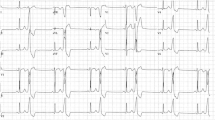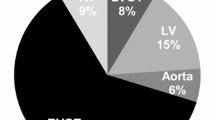Abstract
Background
RF ablation of frequent premature ventricular contractions (PVC) has recently been shown to improve left ventricular (LV) systolic function and dimensions in a few patients, however mainly when they originated from the right ventricular outflow tract.
Methods
RF ablation was performed at various ventricular locations in six consecutive patients with frequent, isolated PVC associated with idiopathic dilated cardiomyopathy (DCM). Baseline clinical status, PVC counts, LV ejection fraction (EF) and end-diastolic diameter (EDD) were recorded at baseline and at 6 months of follow-up.
Results
PVC ablation was performed in the right ventricle in four patients, the left ventricle in two patients. Before RF ablation, five patients were in New York Heart Association (NYHA) functional class I, and one patient was in class II. After RF ablation, the mean PVC count/24 h decreased from 17,717 ± 7,100 to 268 ± 366 (p = 0.006) while LVEF increased from 42 ± 2.5% to 57 ± 3% (p = 0.0001) and LVEDD decreased from 60.0 ± 3.5 to 54.0 ± 3.7 mm (p = 0.0009). The clinical status normalized with regression of palpitations and NYHA class.
Conclusions
Elimination of frequent isolated PVC in patients with DCM with RF can normalize the clinical status and LV systolic function and dimensions, regardless of the morphology or origin of the PVC.
Similar content being viewed by others
References
Galvin, J. M., Ruskin, J. N., Zipes, D., & Jalife, J., (Eds.) (2004). Cardiac electrophysiology from cell to bedside (4th ed., pp. 579–580). Philadelphia, PA: Saunders.
Grogan, M., Smith, H. C., Gersh, B. J., & Wood, D. L. (1992). Left ventricular dysfunction due to atrial fibrillation in patients initially believed to have idiopathic dilated cardiomyopathy. American Journal of Cardiology, 69, 1570–1573.
Lachsinger, J. A., & Steinberg, J. S. (1998) Resolution of cardiomyopathy after ablation of atrial flutter. Journal of the American College of Cardiology, 32, 205–210.
Cruz, F. S., Cheriex, E. C., Smeets, J. L. R. M., Atie, J., Peres, A. K., Penn, O. C. K., et al. (1990). Reversibility of tachycardia-induced cardiomyopathy after cure of incessant ventricular tachycardia. Journal of the American College of Cardiology, 16, 739–744.
Rakovec, P., Lajovic, J., & Dolenc, M. (1989). Reversible congestive cardiomyopathy due to chronic ventricular tachycardia. Pacing and Clinical Electrophysiology, 12, 542–545.
Anselme, F., Boyle, N., & Josephson, M. (1998). Incessant fascicular tachycardia: a cause of arrhythmia induced cardiomyopathy. Pacing and Clinical Electrophysiology, 21, 760–763.
Vijgen, J., Hill, P., Biblo, L. A., & Carlson, M. D. (1997) Tachycardia-induced cardiomyopathy secondary to right ventricular outflow tract tachycardia: improvement of left ventricular systolic function after radiofrequency catheter ablation of the arrhythmia. Journal of Cardiovascular Electrophysiology, 8, 445–450.
Grimm, W., Menz, V., Hoffmann, J., & Maisch, B. (2001). Reversal of tachycardia induced cardiomyopathy following ablation of repetitive monomorphic right ventricular outflow tract tachycardia. Pacing and Clinical Electrophysiology, 24, 166–171.
Duffee, D. F, Shen, W. K., & Smith, H. C. (1998). Suppression of frequent premature ventricular contractions and improvement of left ventricular function in patients with presumed idiopathic dilated cardiomyopathy. Mayo Clinic Proceedings, 73, 430–433.
Chugh, S., Shen, W. K., Luria, D. M., & Smith, H. C. (2000). First evidence of premature ventricular complex-induced cardiomyopathy: a potentially reversible cause of heart failure. Journal of Cardiovascular Electrophysiology, 11, 328–329.
Shiraishi, H., Ishibashi, K., Urao, N., Tsukamoto, M., Hyogo, M., Keira, N., et al. (2002). A case of cardiomyopathy induced by premature ventricular complexes. Circulation Journal, 66, 1065–1067.
Redfearn, D. P., Hill, J. D., Keal, R., Toff, W. D., & Stafford, P. J. (2003). Left ventricular dysfunction resulting from frequent unifocal ventricular ectopics with resolution following radiofrequency ablation. Europace, 5, 247–250.
Yarlagadda, R. K., Iwai, S., Stein, K. M., Markowitz, S. M., Shah, B. K., Cheung, J. W., et al. (2005). Reversal of cardiomyopathy in patients with repetitive monomorphic ventricular ectopy originating from the right ventricular outflow tract. Circulation, 112, 1092–1097.
Sekiguchi, Y., Aonuma, K., Yamauchi, Y., Obayashi, T., Miwa, A., Hachiya, H., et al. (2005). Chronic hemodynamic effects after radiofrequency catheter ablation of frequent monomorphic ventricular premature beats. Journal of Cardiovascular Electrophysiology, 16, 1057–1063.
Takemoto, M., Yoshimura, H., Ohba, Y., Matsumoto Y., Yamamoto U, Mohri M. et al. (2005). Radiofrequency catheter ablation of premature ventricular complexes from right ventricular outflow tract improves left ventricular dilation and clinical status in patients without structural heart disease. Journal of the American College of Cardiology, 45, 1259–1265.
Fenelon, G., Wijns, W., Andries, E., & Brugada, P. (1996). Tachycardiomyopathy: mechanisms and clinical implications. Pacing and Clinical Electrophysiology, 19, 95–106.
Shinbane, J. S., Wood, M. A., Jensen, D. N., Ellenbogen, K. A., Fitzpatrick, A. P., & Scheinman, M. M. (1997). Tachycardia-induced cardiomyopathy: a review of animal models and clinical studies. Journal of the American College of Cardiology, 29, 709–715.
Packer, D. L., Bardy, G. H., Worley, S. J., Smith, M. S., Cobb, F. R., Coleman, R. E., et al. (1986). Tachycardia-induced cardiomyopathy: a reversible form of left ventricular dysfunction. American Journal of Cardiology, 57, 563–570.
Author information
Authors and Affiliations
Corresponding author
Rights and permissions
About this article
Cite this article
Taieb, J.M., Maury, P., Shah, D. et al. Reversal of dilated cardiomyopathy by the elimination of frequent left or right premature ventricular contractions. J Interv Card Electrophysiol 20, 9–13 (2007). https://doi.org/10.1007/s10840-007-9157-2
Received:
Accepted:
Published:
Issue Date:
DOI: https://doi.org/10.1007/s10840-007-9157-2




